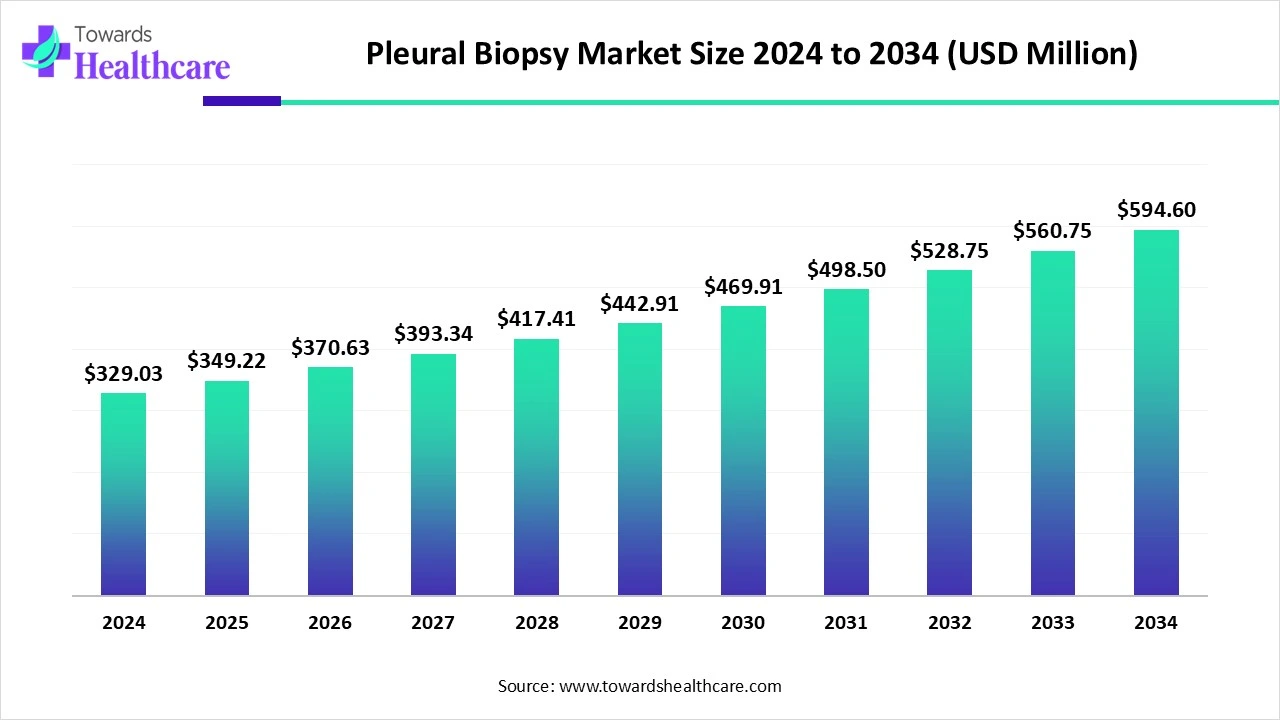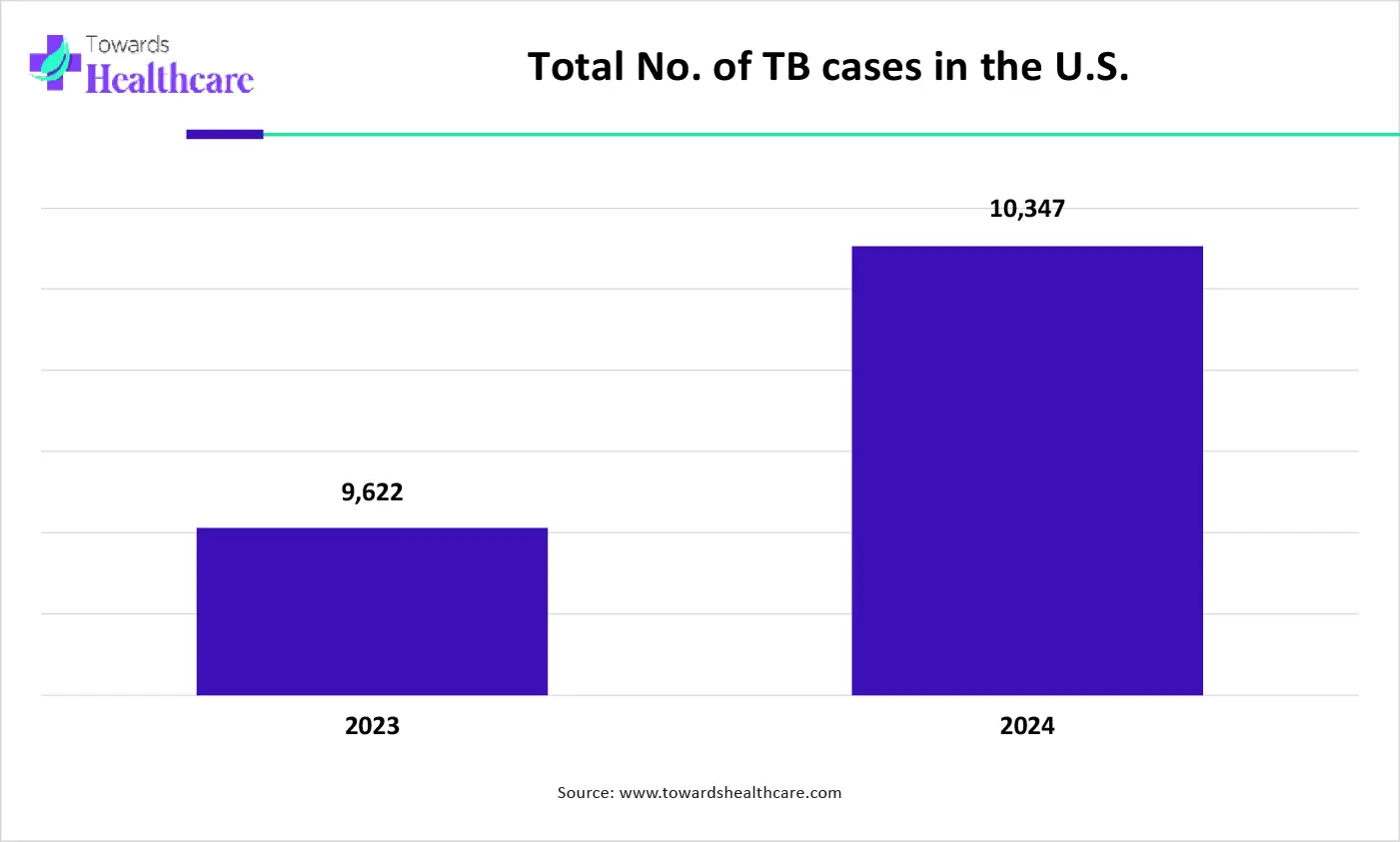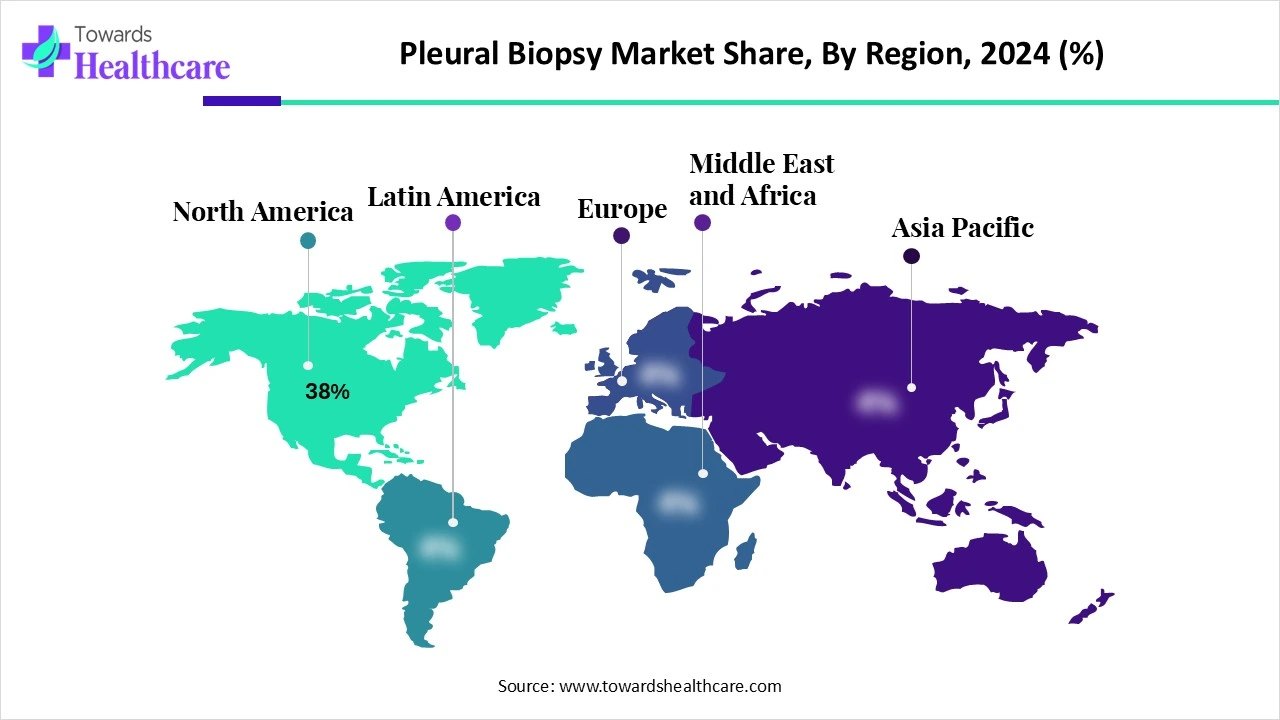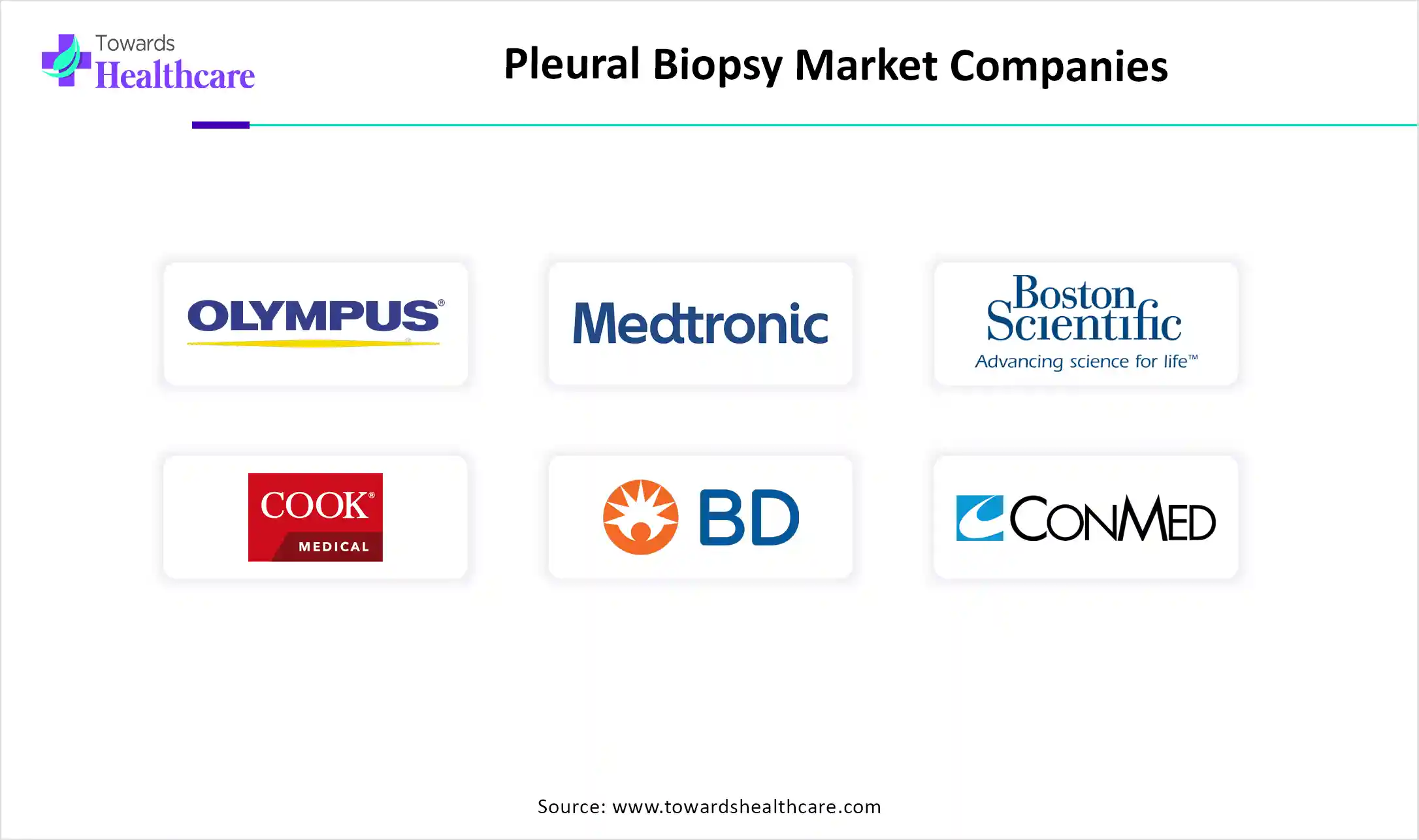December 2025

The global pleural biopsy market size is calculated at US$ 329.03 million in 2024, grew to US$ 349.22 million in 2025, and is projected to reach around US$ 594.6 million by 2034. The market is expanding at a CAGR of 6.14% between 2025 and 2034.

As lung diseases are increasing, the demand for the use of pleural biopsy is increasing. These are used for early and accurate diagnosis of the pleural diseases. This, in turn, is leading to their new research and development, enhancing the innovations, launches, and collaborations among the companies. The use of AI is also increasing to improve its applications. Moreover, increasing adoption of thoracoscopic biopsies, growing TB cases, and increasing awareness are increasing their utilization in different regions. Thus, this is promoting the market growth.
| Metric | Details |
| Market Size in 2025 | USD 349.22 Billion |
| Projected Market Size in 2034 | USD 594.6 Billion |
| CAGR (2025 - 2034) | 6.14% |
| Leading Region | North America Share 38% |
| Market Segmentation | By Technique Type, By Application/Disease Type, By Product Type, By End User, By Region |
| Top Key Players | Olympus Corporation, Medtronic plc, Boston Scientific Corporation, Cook Medical, Inc., BD (Becton, Dickinson and Company, CONMED Corporation, KARL STORZ SE & Co. KG, Johnson & Johnson, Argon Medical Devices, Hologic, Inc., Sterylab S.r.l., Smiths Medical, Zgrum Medical, DTR Medical Ltd., FUJIFILM Holdings Corporation, Veran Medical Technologies, Penumbra, Inc., Scanlan International, Inc., In-Med Prognostics Pvt. Ltd., Scion Medical Technologies |
The pleural biopsy market refers to the segment of the medical diagnostics industry focused on the collection and analysis of pleural tissue samples to diagnose diseases affecting the pleura the thin membrane surrounding the lungs and lining the chest cavity. Pleural biopsies are essential for identifying malignant pleural mesothelioma, metastatic cancers, tuberculosis (TB), empyema, and other pleural pathologies. These procedures can be performed via needle (closed), image-guided (CT/ultrasound), or thoracoscopic (VATS) approaches. The market is driven by the increasing prevalence of pleural diseases, the rise in lung cancer cases, the tuberculosis burden in developing countries, and technological advancements in minimally invasive biopsy techniques.
The use of AI in the pleural biopsy is increasing as it helps in minimizing the clinical workload with the use of AI classification algorithms. It also provides faster and accurate interpretation of the image-based biopsies. It can predict the chances of malignancies and disease progression. AI is also being used for the selection of pleural biopsy procedures. It also helps in the analysis of the genomic data gathered from the pleural biopsy. Moreover, deep learning models are being developed for the detection of tumor features.
Increasing Demands for Early Diagnosis
The increasing lung diseases, such as TB, pleural metastases, mesothelioma, etc., are increasing the demand for early and accurate diagnostic techniques. This, in turn, is increasing the use of pleural biopsy. Hence, the early diagnosis helps in providing early treatment approaches, minimizing the risk of complications. Moreover, it is also being used in the development of personalized medications as it provides molecular profiling, which can be used for the development of site-specific therapies. Thus, this drives the pleural biopsy market growth.

The graph represents the total number of TB cases reported in the U.S. in the years 2023 and 2024. It indicates that there is a rise in cases of TB in 2024. Hence, it increases the demand for pleural biopsy for its early diagnosis and effective management. Thus, this in turn will ultimately promote the market growth.
Limited Access
Sophisticated equipment and experts are required for conducting the pleural biopsy. Thus, the hospitals or clinics with inadequate infrastructure may not be able to utilize it. Moreover, due to their high cost, certain hospitals cannot afford them. This, in turn, can minimize access to pleural biopsy.
Growing Use of Video-Assisted Thoracoscopic Surgery
The use of video-assisted thoracoscopic surgery is increasing, as it provides direct visualization of pleural surfaces. It also provides higher diagnostic accuracy, as it is able to obtain deep tissue samples. Moreover, it is a minimally invasive technique that minimizes the recovery period, enhancing patient outcomes. Hence, it is being used in the diagnosis of complex cancer cases, malignant pleural mesothelioma, etc. This, in turn, is increasing their utilization in various hospitals and clinics. Thus, this promotes the pleural biopsy market growth.
For instance,
By technique type, the needle (closed) pleural biopsy segment held the dominating share of approximately 41% in the market in 2024. It was a widely available technique that increased its use in various hospitals and clinics without the need for any expertise. Moreover, as it was minimally invasive and affordable, its use increased. This contributed to the market growth.
By technique type, the image-guided pleural biopsy segment is expected to show the highest growth at a notable CAGR during the upcoming years. These techniques are providing higher accuracy. Hence, they are being used in the early diagnosis of pulmonary cancer.
In the image-guided pleural biopsy segment, the CT-guided or ultrasound-guided sub-segment is expected to be the fastest growing. They show enhanced accuracy, which minimizes the errors. Thus, they are used in the identification of small and localized lesions. Their use in molecular testing is also increasing.
By application/disease type, the malignant pleural effusion (MPE) segment led the market with approximately 35% share in 2024. The pleural biopsy was used for the accurate detection of MPE. This increased their use in recurrent MPE, and the aging population is affected by it. Moreover, it was also used for the development of personalized treatment options.
By application/disease type, the tuberculous pleuritis segment is expected to show the fastest growth rate during the upcoming years. Due to their growing incidence, the use of pleural biopsy is increasing. This is increasing the adoption of needle or image-guided pleural biopsy. Thus, their early diagnosis reduces the treatment delays.
By product type, the needles & biopsy instruments segment held the largest share of approximately 46% in the market in 2024. These were essential for all pleural biopsy procedures. Moreover, their availability and affordability increased their adoption rates. This has enhanced the market growth.
By product type, the thoracoscopes and VATS equipment segment is expected to show the highest growth during the predicted time. Due to their high accuracy, they are being used in the identification of complex pleural diseases. Moreover, they also provide pleurodesis along with biopsy. This, in turn, is increasing their use.
By end user, the hospitals & tertiary care centers segment led the global market with approximately 54% share in 2024. Different types of pleural biopsy techniques, along with experts, were provided by them. This improved the diagnosis and treatment of the patients. Moreover, the presence of reimbursement polices increased their acceptance rates.
By end user, the tuberculosis control programs segment is expected to show the fastest growth rate during the predicted time. The growing incidence of TB is increasing the adoption of the pleural biopsy. Moreover, the growing awareness through various screening programs conducted by the government is increasing their use. Furthermore, it is also used in the detection of drug-resistant TB.

North America dominated the pleural biopsy market share by 38% in 2024. The presence of the advanced healthcare sector in North America increased the use of various biopsies. This, in turn, increased the adoption of the thoracoscopic biopsies. This contributed to the market growth.
The industries as well as the institutes in the U.S. are contributing to new research and developments for enhancing the accuracy of the pleural biopsies. Thus, various technologies are being merged with these techniques to develop modern diagnostic tools. This, in turn, is leading to new collaboration among them.
The growing incidence of lung cancer is increasing the use of pleural biopsies. Moreover, the presence of reimbursement policies is increasing their use. Therefore, various AI-based molecular diagnostic tools are also being developed. This is further supported by the investments from various sources.
Asia Pacific is expected to host the fastest-growing pleural biopsy market during the forecast period. Asia Pacific is experiencing a rise in cases of TB, which is increasing the demand for diagnostic tools, such as pleural biopsy. Moreover, due to expanding healthcare, their adoption is increasing. This enhances the market growth.
Due to growing lung disease and awareness in China, the industries are developing various diagnostic tools. This, in turn, is promoting the development of pleural biopsy. Moreover, advanced technologies are being used to make these tools more affordable. Their development is being supported by the government initiatives as well.
The healthcare sector in India is expanding. Therefore, to deal with the growing lung diseases, the adoption of pleural biopsy is increasing. New centres are also being established with the support of government health initiatives. Furthermore, the growing medical tourism is also driving their use.
Europe is expected to grow significantly in the pleural biopsy market during the forecast period. The increasing awareness in Europe is increasing the demand for pleural biopsy for early detection of various diseases. This is increasing their innovations and adoptions. Thus, this is promoting the market growth.
The growing diseases in Germany are increasing the research and development by the industries and institutes for the advancements in pleural diagnostics. This is supported by the government funding. Moreover, the presence of a robust healthcare infrastructure is increasing the utilization of CT-guided and ultrasound-guided biopsy techniques.
Due to growing awareness, through various government screening programs and campaigns for thoracic cancer, the demand for pleural biopsy is increasing. Furthermore, the growing rare diseases is also increasing their use. Thus, various funding is also being provided for the development of AI-powered pleural biopsy techniques.

In July 2025, after the launch of the global post-market evaluation of the biopsy tract closure device by Single Pass Inc., the chief of interventional radiology at Hoag Hospital in Irvine, CA, Dr. Alexander Misono, stated that the advancements in the world of core needle biopsy can be enhanced with the SinglePass device. The bleeding risk and patient recovery are being managed with the use of the SinglePass, as it offers reliable and immediate tract closure. Moreover, he stated that he is honoured to be a part of this evaluation and will help to enhance the future standard of care.
By Technique Type
By Application/Disease Type
By Product Type
By End User
By Region
December 2025
November 2025
November 2025
November 2025